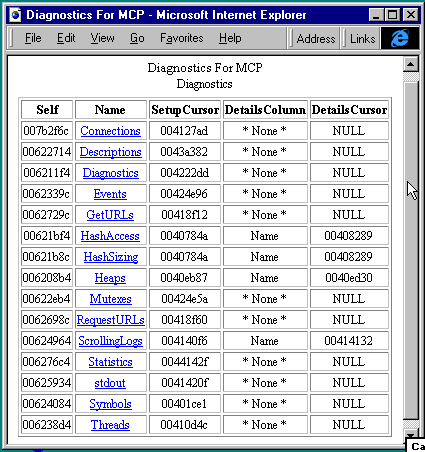

 |  |
| MISSION PRODUCTS NEWS CONTACT | |
| Communications Infrastructure - C I | |
The Communications Infrastructure (CI) is a cross-platform, client-server/peer-to-peer application-enabling platform supporting the development of distributed, inter-operating, high performance, web-protocol-based applications.
Primary FunctionsCI's primary functionality includes:
|
Utility FunctionsCI provides various support functions including:
|
CI provides the latest approach to Graphical User Interface (GUI) implementation. A User Interface Server (UIS) is supplied that allows all screens and reports to be generated using industry standard HyperText Markup Language (HTML RFC 1866) making them immediately available to any platform on the network with a compliant browser. Per the HTML RFC1866:
| The HyperText Markup Language (HTML) is a simple data format used to create hypertext documents that are portable from one platform to another. HTML documents are SGML documents with generic semantics that are appropriate for representing information from a whide range of domains. |
UIS also provides server-side scripting using the REXX language. REXX code is embedded directly within HTML source files and is interpretted by UIS when pages are requested by a browser client. UIS directly executes the REXX scripts without spawning a separate process like cgi-bin scripts. UIS also provides the ability to track a "golden thread" of client interaction without the use of browser-based "cookies".
CI uses the HyperText Transfer Protocol standard (Internet Draft 5 of the HTTP Working Group within the IETF) for all inter-process communications. HTTP is designed to deliver far more than simple HyperText documents coded using HTML. In fact, the draft itself states:
| The Hypertext Transfer Protocol (HTTP) is an application-level protocol with the lightness and speed necessary for distributed, collaborative, hypermedia information systems. It is a generic, stateless, object-oriented protocol which can be used for many tasks, such as name servers and distributed object management systems, through extension of its request methods (commands). A feature of HTTP is the typing of data representation, allowing systems to be built independently of the data being transferred. |
All inter-process communications within the CI are delivered via the HTTP protocol. The messages are delivered in pure binary form with endian-neutrality included only where required by the operating platform.
DiagnosticsCI's HTML-based diagnostic pages provide visibility into the internal workings of remote processes. Each CI-based process is a complete web server offering pages reflecting the current state of the process. Application-specific diagnostic pages can be added with ease to view pertinent data structures or decision paths. CI-provided default diagnostic pages include the ability to view current connections, event and mutual exclusion semaphores, hash table sizing and contents, performance statistics, executing threads, and scrolling log information. Of particular use during product development, CI provides sizing and usage statistics for various memory heaps. This information, when coupled with detailed contents viewing capability, provides an invaluable tool to detect and correct memory leaks in applications before they are deployed. CI also provides a message testing facility that allows any request to be initiated from a suitably authenticated browser. Application implementers can now test their services without writing a single line of throwaway testing code. |

|
Contact
For additional information, please contact:
 |
Compass Solutions, Inc. |
| Copyright © 2000 Compass Solutions, Inc. |